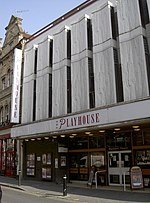Woodspring Priory (originally Worsprynge or Worspring) is a former Augustinian priory. It is near the scenic limestone promontory of Sand Point and Middle Hope, owned by the National Trust, beside the Severn Estuary about 3 miles (5 km) north-east of Weston-super-Mare, within the English unitary authority of North Somerset. Many of the buildings are Grade I listed, and the whole site is scheduled as an ancient monument.The priory was founded, by William de Courtney, in the early 13th century, and dedicated to Thomas Becket. The small community built a church and monastic lodgings during the next hundred years. They were Victorine Canons who were influenced by the Cistercians who emphasised manual labour and self-sufficiency so that the clerks who had taken holy orders worked on the farm, as well as providing clergy for surrounding churches. Despite endowments of land the priory was not wealthy until the 15th century when further building work, including the current priory church, infirmary and barn was undertaken. It was dissolved in 1536 and then owned by local noblemen and leased to local farmers. In 1968 the priory and adjoining land of Middle Hope was purchased by the National Trust for Places of Historic Interest or Natural Beauty as part of Project Neptune. The following year the priory was taken over by the Landmark Trust who spent 20 years on restoration work, and now rent out the farmhouse as holiday accommodation.
The surviving buildings include the priory church, which was a 15th-century replacement for the earlier 13th-century structure, infirmary, barn and 16th-century prior's lodging which was converted into a farmhouse. The whole site was arranged around a central cloister from which only the east wall and west wall of the chapter house remain, the sacristy, refectory, chapter house, lady chapel and parlour having been demolished. The former district council and parliamentary constituency both took their name from the priory.











